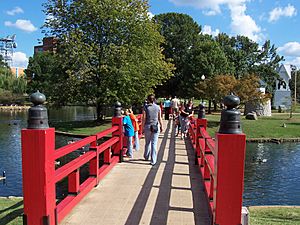Big Spring Park (Huntsville, Alabama) facts for kids
Quick facts for kids |
|
|
Big Spring
|
|

Big Spring Park
|
|
| Location | W. Side Sq., Huntsville, Alabama |
|---|---|
| Area | 12.5 acres (5.1 ha) (park) |
| MPS | Downtown Huntsville MRA |
| NRHP reference No. | 80000704 |
| Added to NRHP | September 22, 1980 |
Big Spring International Park (also known as Big Spring Park) is a cool park in downtown Huntsville, Alabama. It's built around a huge natural spring called "Big Spring." This spring was the first water source for the city of Huntsville!
You can find the Huntsville Museum of Art and the Von Braun Center right inside the park. Big Spring Park is also famous for hosting fun events. These include the Panoply Arts Festival in April and, in the past, the Big Spring Jam music festival. It also hosts The Battle of the Buffalo, a buffalo wings contest that helps cancer research.
The park is also the starting point for the future Singing River Trail. This 70-mile path will be great for biking and walking. It will connect Huntsville to nearby cities like Madison, Decatur, and Athens. The trail will even follow the Tennessee River for a bit!
The Big Spring's Story
| "Huntsville is situated around the finest spring in the world; the spring forms a semicircle 100 feet wide, and at a trivial expense the stream can be made navigable for batteaux to the Tennessee river; which is only ten miles distant." |
| - future U.S. Senator John Williams Walker, 1815
to his friend and US Secretary of War William H. Crawford |
The Big Spring is a huge underground karst spring. A karst spring is where water flows out from cracks in limestone rock.
In 1805, John Hunt, who founded Huntsville, heard about this amazing spring. He also heard about all the big game animals nearby. He settled close to the spring, on a bluff where the First National Bank of Huntsville now stands.
Before John Hunt, Isaac and Joseph Criner found the spring. But they left because there were too many bears and mosquitoes! They decided to settle in New Market instead.
For a long time, the Big Spring was Huntsville's main water source. It's the biggest limestone spring in North Alabama. It usually flows with 7 to 20 million US gallons (76,000 m3) of water every day! The amount of water depends on the time of year.
Water for the City
From the 1820s to the 1840s, a canal called the Fearn Canal was built. This canal connected downtown Huntsville and the spring to the Tennessee River. It helped traders move goods without expensive wagon trips. But when railroads were built, the canal was no longer needed.
The Big Spring also supplied water to the city until the late 1960s. That's when a new water treatment plant was built on the Tennessee River. The first building to pump water was set up in the 1830s. It used a water turbine to push water up to the city through wooden pipes.
In 1840, the city bought the water system from the family of an early settler, LeRoy Pope. His family got free water for life. Also, the area around the Big Spring had to be open to the public.
Over the years, new pump houses were built and updated. The last one stood until the 1960s.
The Park Today
Big Spring Park gets its name from the "big spring" that the native Cherokee and Chickasaw people named. The park is in downtown Huntsville, starting near the courthouse square. It includes the spring and a canal.
Park construction began in 1898. Colonel Hiram M. Chittenden of the U.S. Army Corps of Engineers helped with the work. He found that horse waste from the courthouse was getting into the city's water supply. So, he and his team tore down the old pump house. They put in a fountain and lined the canal between 1898 and 1901.
The park grew over time. In 1968, it expanded across Church Street to include a lagoon. In 2005, it expanded again across Monroe Street. This new part includes a beautiful fountain and a canal next to the Von Braun Center.
Gifts from Around the World
Today, the park is famous for gifts from other countries. Norway gave Huntsville a light beacon (often called "the lighthouse") in 1973. They also gave a fog bell. Other smaller gifts include a bench from the United Kingdom and a sundial from Germany.
The most well-known gifts are the red Japanese bridge and the cherry trees. These were given by Japanese Major General Mikio Kimata. He studied at Redstone Arsenal from 1964 to 1966. To thank Huntsville for its kindness, he donated 60 Yoshino Cherry trees.
Later, in 1977, he gave a "friendship bridge" to celebrate the United States' 200th birthday. In 1998, the bridge was renovated with help from Kimata and the Japanese Society of Alabama. It was made wider and easier to walk across.
Another special gift is the marble lion statue. It sits near the Big Spring Fountain. The city received this lion when the park first opened. In the 1960s, some vandals pushed it into the canal. But it was found and restored in 1995, returning to its place in the park.
Big Spring Park was also a filming location for the 2005 movie Constellation.





